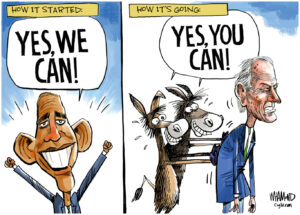Obama Drills a Hole in His Climate Policy
Here are two facts that cannot be reconciled: The planet has experienced the warmest January-through-March on record, and the Obama administration has authorized massive new oil drilling in the Arctic Ocean. Drop of Light / Shutterstock.com
Drop of Light / Shutterstock.com
WASHINGTON — Here are two facts that cannot be reconciled: The planet has experienced the warmest January-through-March on record, and the Obama administration has authorized massive new oil drilling in the Arctic Ocean.
“Climate change can no longer be denied … and action can no longer be delayed,” President Obama said in an Earth Day address in the Everglades. Indeed, Obama has been increasingly forceful in raising the alarm about heat-trapping carbon emissions. “If we don’t act,” he said in Florida, “there may not be an Everglades as we know it.”
Why, then, would the Obama administration give Royal Dutch Shell permission to move ahead with plans for Arctic offshore drilling? Put simply, if the problem is that we’re burning too much oil, why give the green light to a process that could produce another million barrels of the stuff per day, just ready to be set alight?
Please hold the pedantic lectures about how the global oil market works: Demand will be met, if not by oil pumped from beneath the Arctic Ocean then by oil pumped from somewhere else. By this logic, the administration’s decision is about energy policy — promoting U.S. self-sufficiency and creating jobs — rather than climate policy. The way to reduce carbon emissions, according to this view, is by cutting demand, not by restricting supply.
But we are told by scientists and world leaders, including Obama, that climate change is an urgent crisis. And on the global scale — the only measure that really matters — the demand-only approach isn’t working well enough. More than two decades after the first international summit on climate change, carbon emissions have continued to rise steadily.
The concentration of carbon dioxide in the atmosphere is an astounding 40 percent higher than it was at the beginning of the Industrial Revolution, when large-scale burning of fossil fuels began. Fourteen of the 15 warmest years on record have occurred this century, with 2014 measured as the warmest of all. And the National Oceanic and Atmospheric Administration announced last month that January through March 2015 were the warmest first three months of the year ever recorded.
It’s not that demand-side efforts are entirely ineffectual against climate change; without them, emissions and temperatures would be rising even faster. But it is hard to argue that the current approach is doing enough.
The fact is that if we are going to avert the kind of temperature rise that climate scientists say would be catastrophic, some of the oil, coal and natural gas buried in the ground will have to stay there. And if any place should be put off-limits for exploitation, it seems to me, it should be the environmentally delicate Arctic.
“Drill, baby, drill” was a slogan Republicans used during the 2008 campaign, but it became a reality under Obama. According to the U.S. Energy Information Administration, domestic oil production zoomed from 5.4 million barrels a day in 2009 to 8.7 million barrels a day last year, a level not seen since the waning days of the Reagan administration.
Obama has opened vast new lands and offshore tracts to oil drilling. To be fair, he has also put some sensitive areas off-limits, including in the Arctic. But overall, under Obama, the United States has come to threaten the likes of Saudi Arabia and Russia for supremacy in fossil-fuel production.
This is part of what Obama calls his “all of the above” energy strategy, in which he fosters growth and innovation in renewable energy sectors, such as solar and wind, while also promoting U.S. self-sufficiency by encouraging the boom in oil and natural gas.
Anticipated rules from the Environmental Protection Agency limiting emissions at coal-fired power plants may go a long way toward reducing the nation’s carbon footprint. But given the urgency, why shouldn’t Obama take an “all of the above” approach to climate change as well? Since some oil has to stay where it is, why not attack the supply side of the equation by firmly deciding to keep drilling rigs out of the Arctic Ocean?
The environmental risk alone would justify saying no to Shell’s plans; a big spill would be a disaster. But even if Arctic oil can be exploited without mishap, we’re talking about billions of gallons of oil being added to a market that is presently glutted. It doesn’t matter whether that oil is eventually burned in New York or New Delhi, in Los Angeles or Lagos.
If we don’t take a stand in the Arctic, then where? And if not now, when?
Eugene Robinson’s email address is [email protected].
© 2015, Washington Post Writers Group
Your support matters…Independent journalism is under threat and overshadowed by heavily funded mainstream media.
You can help level the playing field. Become a member.
Your tax-deductible contribution keeps us digging beneath the headlines to give you thought-provoking, investigative reporting and analysis that unearths what's really happening- without compromise.
Give today to support our courageous, independent journalists.








You need to be a supporter to comment.
There are currently no responses to this article.
Be the first to respond.